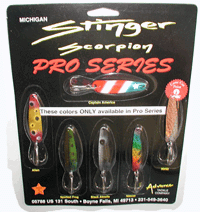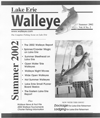|
Breakline Basics
By Rick Olson
The key to finding and catching big walleyes is quite often found along a
change in depth or drop off (a.k.a. break line). Break lines can concentrate
fish, and concentrations are exactly what youíre looking for just about 100
percent of the time. The idea is to keep your bait in front of as many
walleyes as you
 can
for as long as you can. The end result should be more fish in the boat by
the end of the day, and more walleyes is what itís all about. By getting a
bait in front of the heaviest concentrations of fish you can greatly improve
your odds of finding the willing. can
for as long as you can. The end result should be more fish in the boat by
the end of the day, and more walleyes is what itís all about. By getting a
bait in front of the heaviest concentrations of fish you can greatly improve
your odds of finding the willing.
Within a large school of walleyes there will almost always be a few that
will be active enough to take a bait, even if the rest of the pack is not.
The fact is they donít always do the same things at the same time, even when
theyíre stacked up in a dense concentration. Finding said concentrations
often starts at the break line, wherever that may be.
You can refine the activity along a break line even further and try to
determine whether the walleyes along the top, the middle, or at the base of
the break are the biters. Quite often youíll find a group of fish spread out
up and down a break line but only certain ones are actively feeding at any
given time. A good rule of thumb includes the shallowest fish you find being
the most likely to take a bait.
A deep to shallow feeding movement is a classic one, and occurs both in
deep water as well as in shallow. For example, walleyes holding on a deep
off shore hump will often hold along the break line of the edge and move up
on top during peak times of activity. The same thing happens on shallow
rocky bars and reefs where walleyes hold along an edge which could be five
feet deep or shallower, and move up into super shallow water when the timing
is right. In either case the break line is where youíre likely to find the
heaviest concentrations, but not necessarily where youíll locate the heavy
feeders.
Break lines by themselves are not enough to pull in active walleyes, but
a break line combined with a good feeding opportunity certainly is. Break
lines or drop offs that lie next to a big feeding shelf is the stuff that
quality time on the water is made of. Breaks next to shelves, rocky bars, or
even flats are what youíre looking for, and where and when will depend on
the characteristics of the lake system you happen to be on, and time of the
year.
A break line next to a big deep hump might be holding absolutely nothing
if you get there too early, or if the water is too dark, or if itís below
the thermocline. Time spent where theyíre not is time wasted, and a
situation to try and avoid. The thing is there will be some time wasted in
your search for the mother of all schools of walleyes but you can try and
keep it to a minimum.
Finding likely break lines begins by gathering a little basic knowledge
about a system, and then taking a hard look at a good map. A detailed map
with latitude and longitude markings can be a big help, especially if you
have an accurate G.P.S. to help exploit the information. A chart plotter
like the Raymarine can keep your search time to a bare minimum, which allows
for more time spent with a line in the water. By transferring break line
readings into the G.P.S. you can take a direct heading for potential hot
spots and the Raymarine can get you to within three meters of what youíre
looking for. A G.P.S. can be critical for finding off shore break lines on
big water, and may be just about impossible to do so without.
Once youíve found what your looking for take a good look with your depth
finder and see if anything is around before you drop them a line. If youíre
marking fish try to find the tightest groups or concentrations, and take
note of exactly where theyíre located. Try looking up and down the break
line and even up directly on top of the accompanying structure. A good plan
of action would include going back and working the shallowest fish first,
and heading deeper from there.
Donít let the first fish you mark stop you from investigating thoroughly
before you get a line in the water. Even if you mark what looks like the
mother load take a little more time and check it all out before trying to
put a few in the boat. It requires a good deal of self control but can pay
big dividends in the long run. How you approach a break line will depend on
the time of the year, and the type of structure, and just how tight the fish
are bunched up. Fish that are spread out require a different presentation
than those that are piled into a tight area. Tight schools likely call for
rigging and jigging techniques, while loose groups may be more efficiently
worked with much quicker trolling methods like lead core and crank bait
combinations. Lead core can allow you to run a bait at an exact depth, and
do so quickly resulting in more water covered (and explored) over the course
of a day.
Lead core is a weighted line that sinks, and allows anglers to get their
baits to run deeper than they are capable of on their own. It also has
little stretch, and transmits the rhythmic vibration of a properly running
crankbait back to the rod tip. You can literally see how your bait is
running by concentrating on the tip. If itís consistently twitching, youíre
running clean. If it pulls back hard and pops forward, youíre digging into
the bottom. Reel up a little line and watch the tip, and keep picking up
line until it runs free. Itís OK to occasionally bang into the bottom; That
can help trigger fish into striking. But a bait thatís constantly grinding
into the bottom will be constantly hanging up. Also, a small change in depth
can get you back digging into the bottom, or put the bait too high to be in
the zone. Constant monitoring of the rod tip is a necessity, and one of the
most important keys to successful contour trolling.
It takes some time to get comfortable with the whole affair but once you
do youíll be in control of a tool with an unmatched level of precision.
|





 can
for as long as you can. The end result should be more fish in the boat by
the end of the day, and more walleyes is what itís all about. By getting a
bait in front of the heaviest concentrations of fish you can greatly improve
your odds of finding the willing.
can
for as long as you can. The end result should be more fish in the boat by
the end of the day, and more walleyes is what itís all about. By getting a
bait in front of the heaviest concentrations of fish you can greatly improve
your odds of finding the willing.